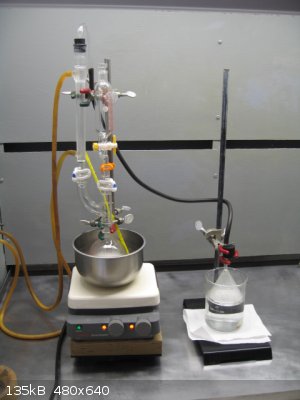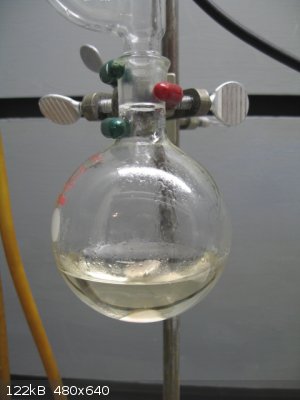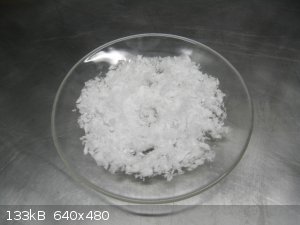Magpie
lab constructor
    
Posts: 5939
Registered: 1-11-2003
Location: USA
Member Is Offline
Mood: Chemistry: the subtle science.
|
|
preparation of maleic anhydride
For this preparation I followed the procedure in Vogel, 3rd ed, p.462. The formative chemical reaction is shown here:
Attachment: maleic anhydride.tif (44kB)
This file has been downloaded 790 times
A. Apparatus
A 250ml RBF with Claisen adapter was set up in a water bath atop a magnetic stirrer-hotplate. In the center neck was placed a 50ml p-e addition
funnel. In the other neck was placed a 20cm condenser. Off-gas from the condenser (HCl) was led to an inverted funnel over 400ml of 10%NaOH.
B. Procedure
1. Reaction 45g of malic acid (Brewcraft) and a stir bar were placed in the RBF. 57ml of acetyl chloride (homemade) was placed in the p-e
funnel. Hot tap water was placed in the water bath. The acetyl chloride was then slowly dripped on to the malic acid over a ½ hr period as shown
here:

This resulted in slow bubbling of the reactants. HCl gas was generated resulting in a strong heat of reaction at the NaOH absorber. The reaction
took a long time to become fluid enough to mix. Toward the end of this reaction period (4 hrs) the water bath temperature was brought slowly up to
68°C. At the end of this period the product was a clear liquid, as shown here:

2. Distillation The set-up was reconfigured for simple distillation using a heating mantle. Initially a fog was emitted from the
tubulation on the vacuum adapter, assumed to be HCl. (Hood fan ON!). Next a forerun began coming off at 40°C. This was collected until the still
head temperature was 190°C, per procedure. This was assumed to be acetic acid, water, and any unreacted acetyl chloride. The receiver was then
switched, water run out of the condenser, and maleic acid was collected through a temperature range of 190-205°C.
3. Crystallization The clear molten product was poured into an evaporating dish. After 5hrs the product had still not solidified. By the
next morning it had formed into a matrix of ½” long crystals. However the somewhat slushy product smelled very strongly of acetic acid. It was
then recrystallized from chloroform and left to air-dry overnight. The final product is shown in the watchglass:

C. Results The melting point was 49-52°C. The Wiki value is 52.8°C. The yield was 17.1g (Vogel: 22g) for a %yield of 52%.
D. Discussion The reactants took a long time to form a clear product, at least 4 hrs. This probably could have been speeded up if
I had raised the water bath temperature closer to boiling. I held back for fear of charing.
I lost a little yield, maybe a gram or so, due to an unsecured joint popping open and a clumsy switching of receivers.
My product purity could likely be improved by a second recrystallation in chloroform.
Maleic anhydride is potentially a very useful precursor. An obvious use would be in the Diels-Alder reactions.
Comments, suggestions, and questions are welcomed.
[Edited on 29-4-2017 by Magpie]
The single most important condition for a successful synthesis is good mixing - Nicodem
|
|
|
Cryolite.
Hazard to Others
  
Posts: 269
Registered: 28-6-2016
Location: CA
Member Is Offline
Mood: No Mood
|
|
Nicely done! Although, the use of acetyl chloride seems a bit excessive. Have you tried direct heating?
|
|
|
Magpie
lab constructor
    
Posts: 5939
Registered: 1-11-2003
Location: USA
Member Is Offline
Mood: Chemistry: the subtle science.
|
|
Thanks. No I just assumed that the Vogel authors knew what they were doing. 
The single most important condition for a successful synthesis is good mixing - Nicodem
|
|
|
AvBaeyer
National Hazard
   
Posts: 644
Registered: 25-2-2014
Location: CA
Member Is Offline
Mood: No Mood
|
|
Magpie,
Nicely done! Great to have you back in the lab again.
I have been meaning to make some maleic anhydride myself. I have purchased material from three different suppliers and all has been severely
contaminated with the acid. Why this should be so I do not know.
As for routes of synthesis from malic acid, the Vogel prep is quite typical. Trifluoroacetic anhydride is an alternate reagent. I have seen no reports
of using acetic anhydride which seems to stop at the O-acetyl derivative of malic anhydride. Apparently the presence of a strong acid is necessary to
effect the elimination to the O-acylated malic anhydride to maleic anhydride hence the use of acetyl chloride or TFA. Perhaps malic acid and acetic
anhydride with catalytic sulfuric acid or p-toluenesulfonic acid might work.
I have attached a rather lengthy review which contains some comments on alternative routes of synthesis buried deep within. A second paper of interest
which claims azeotropic dehydration of maleic acid is also attached.
Again, nice work - all that homemade acetyl chloride - amazing!
AvB
Attachment: MALEIC ANHYDRIDE, MALEIC AND FUMARIC ACIDS REVIEW.pdf (178kB)
This file has been downloaded 5799 times
Attachment: Prep of Maleic Anhydride mason1930.pdf (122kB)
This file has been downloaded 310 times
[Edited on 30-4-2017 by AvBaeyer]
|
|
|
JJay
International Hazard
    
Posts: 3440
Registered: 15-10-2015
Member Is Offline
|
|
Bravo! Bravo!
|
|
|
Magpie
lab constructor
    
Posts: 5939
Registered: 1-11-2003
Location: USA
Member Is Offline
Mood: Chemistry: the subtle science.
|
|
Thank you AvB and JJay. Yes, it is good to be back in the lab.
The single most important condition for a successful synthesis is good mixing - Nicodem
|
|
|